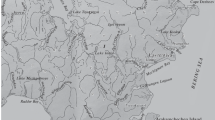Abstract
Growth rate, instantaneous growth rate and energy budget ofPila globosa in an artificial pond were estimated using marking and recapture method. A decrease in growth rate and instantaneous growth rate were noticed with the increase in body weight. The life span ofP. globosa assessed was more than 4 years. The rates of feeding, absorption and metabolism of different weight-classes have also been studied.
Similar content being viewed by others
References
Ansell A D and Trevallion A 1967 Studies onTellina tenius (Da Costa) 1. Seasonal growth and biochemical cycle;J. Exp. Mar. Biol. Ecol. 1 220–225
Berry A J 1962 The growth ofOpisthostoma retrovertens (Tomlin), a minute cyclophorid from a Malaysian limestone hill;Proc. Malacol. Soc. 35 46–49
Carefoot T H 1967 Growth and nutrition ofAplysia punctata feeding on a variety of marine algae;J. Mar. Biol. Assoc. U.K. 47 565–590
Carefoot T H 1970 A comparison of absorption and utilisation of food energy in two species of tropicalAplysia;J. Exp. Mar. Biol. Ecol. 5 47–62
Gerking S D 1954 The food turnover of a blue gill population;Ecology 35 490–498
Grahame J 1973 Assimilation efficiency ofLittorina littorea (L);J. Anim. Ecol. 42 383–389
Haniffa M A 1975Ecophysiological studies in a chosen gastropod; Ph.D. Thesis, Madurai University
Haniffa M A 1978a Secondary productivity and energy flow in a tropical pond;Hydrobiologia 59 49–66
Haniffa M A 1978b Energy loss in an aestivating population of the tropical snailPila globosa;Hydrobiologia 61 169–182
Haniffa M A and Mullainathan P 1980 Studies on energy transformation in the freshwater snailViviparus variatus. Proc. V Int. Symp. Tropical Ecology (in press)
Haniffa M A and Pandian T J 1974 Effects of body weight on feeding and radula size in the freshwater snailPila globosa;The Veliger 16 415–418
Haniffa M A and Pandian T J 1978 Morphometry, primary productivity and energy flow in a tropical pond;Hydrobiologia 59 23–48
Hughes R N 1971 Ecological energetics of the keyhole limpetFissurella barbadensis (Gmelin);J. Exp. Mar. Biol. Ecol. 6 167–178
Hyman L H 1967The Invertebrate Part I (New York: McGraw Hill) Vol. VI p. 792
Krishnamoorthy R V 1968 Hepatopancreatic unsaturated fatty acids during aestivation o snailPila globosa;Comp. Biochem. Physiol. 24 279–282
Macfadyen A 1967 Methods of investigation of productivity of invertebrates in a terrestrial systems inSecondary productivity of terrestrial ecosystems ed K Petrusewicz (Panstweco-Wydownicwo Naukowe, Warsaw), pp 383–412
Mason C F 1970 Food, feeding and assimilation in woodland snails;Oecologia 4 358–375
Mason C F 1971 Respiration rates and population metabolism of woodland snails;Oecologia 7 80–94
Odum E P 1962 Relationship between structure and function in the ecosystem; Japanese.J. Ecol. 12 108–118
Odum E P 1971Fundamentals of ecology; (Philadelphia: W. B. Saunders) p. 574
Odum E P and Smalley A E 1959 Comparison of population energy flow of a herbivorous and a deposit feeding invertebrate in a saltmarsh ecosystem;Proc. Natl. Acad. Sci. U.S.A. 46 617–622
Paine R T 1971 Energy flow in a natural population of the herbivorous gastropodTegula funebralis;Limnol. Oceanogr. 16 86–98
Petrusewicz K and Macfadyen A 1970Productivity of terrestrial animals; I.B.P. Hand Book No. 13 (Oxford: Blackwell) p 190
Slobodkin L B 1962 Energy in animal ecology;Adv. Ecol. Res. 1 69–101
Van Heukelem W F 1973 Growth and life span ofOctopus cyanea;J. Zool. 169 299–305
Vivekanandan E, Haniffa M A, Pandian T J and Raghuraman R 1974 Studies on energy transformation in the freshwater snailPila globosa. 1. Influence of feeding rate;Freshwater Biol. 4 275–280
Vivekanandan E and Pandian T J 1976 Food utilization and mineral efficiency in the snailGyraulus convexiusculus;J. Madurai. Univ. 5 66–72
Wilbur K M and Yonge C M 1968Physiology of mollusca; (New York: Academic Press)1 p. 473
Author information
Authors and Affiliations
Rights and permissions
About this article
Cite this article
Haniffa, M.A. Studies on life span, growth increments and energy budget of the freshwater snailPila globosa (Swainson) in an artificial pond. Proc. Indian Acad. Sci. (Anim. Sci.) 89, 275–286 (1980). https://doi.org/10.1007/BF03179169
Received:
Revised:
Issue Date:
DOI: https://doi.org/10.1007/BF03179169




